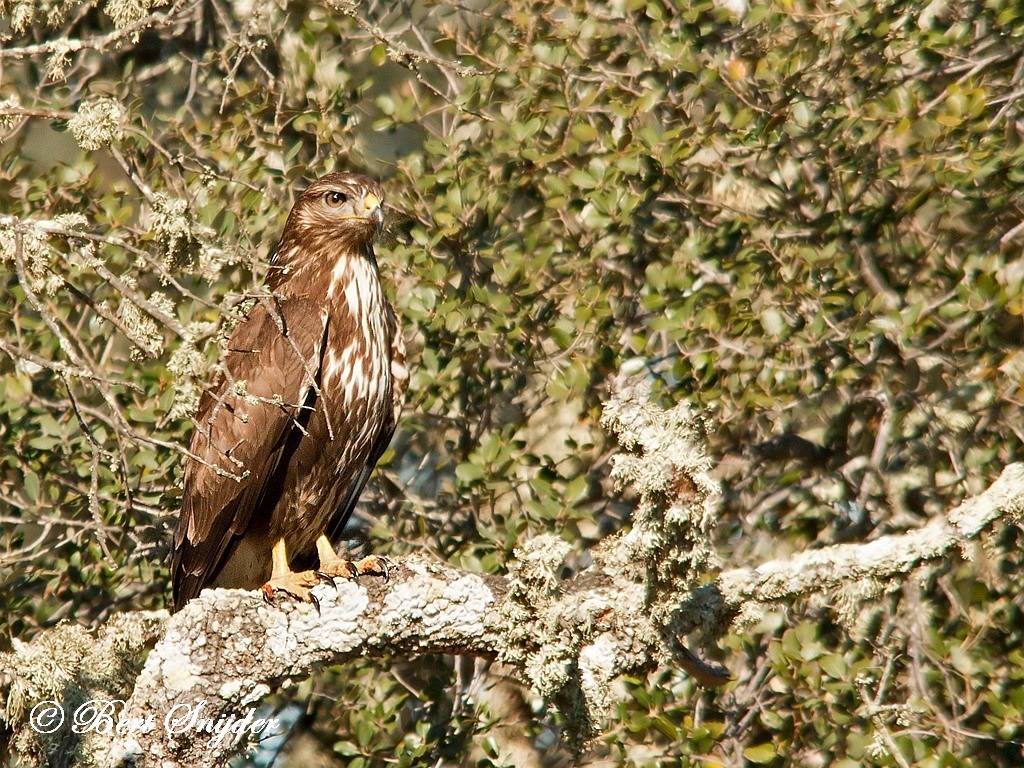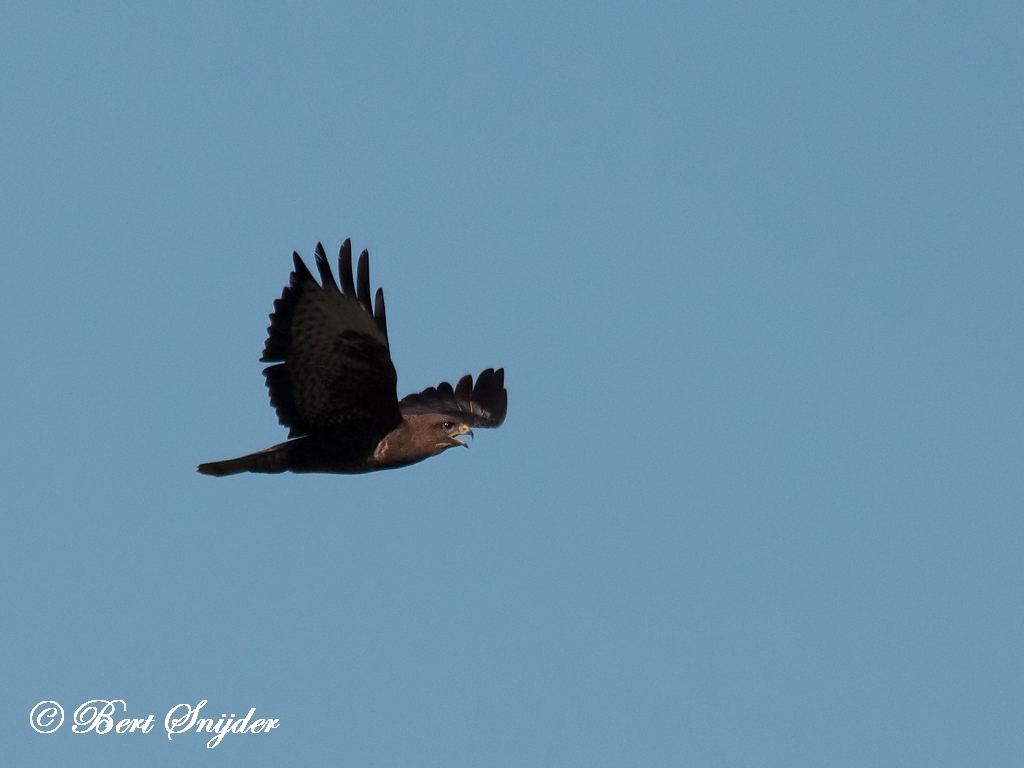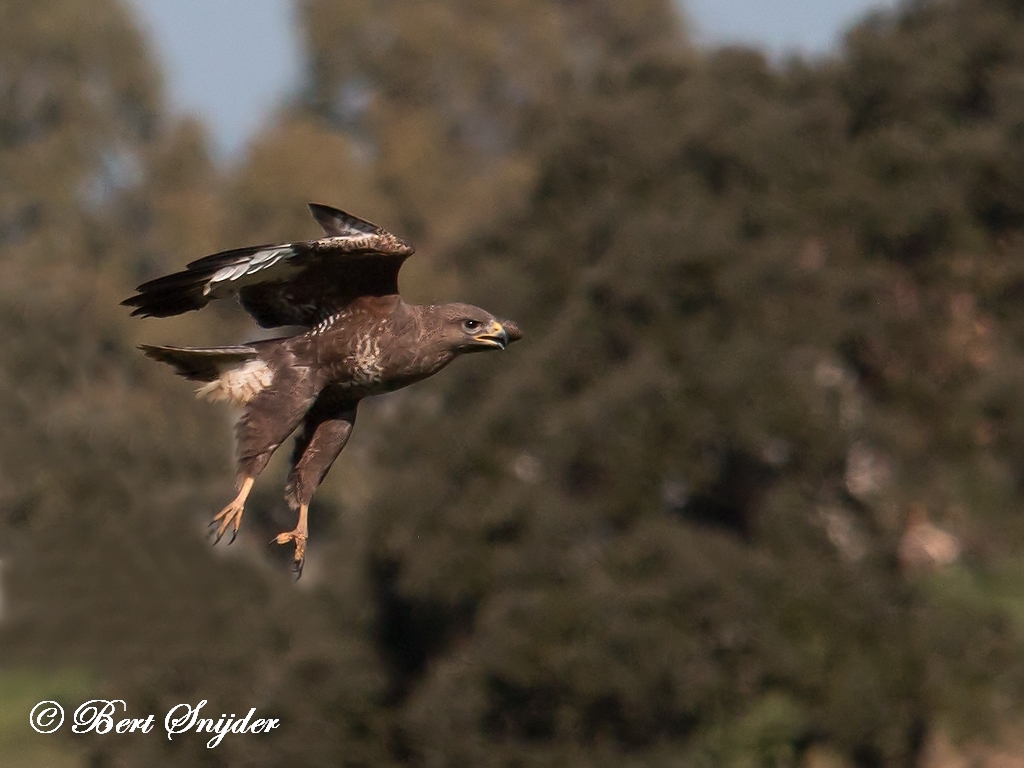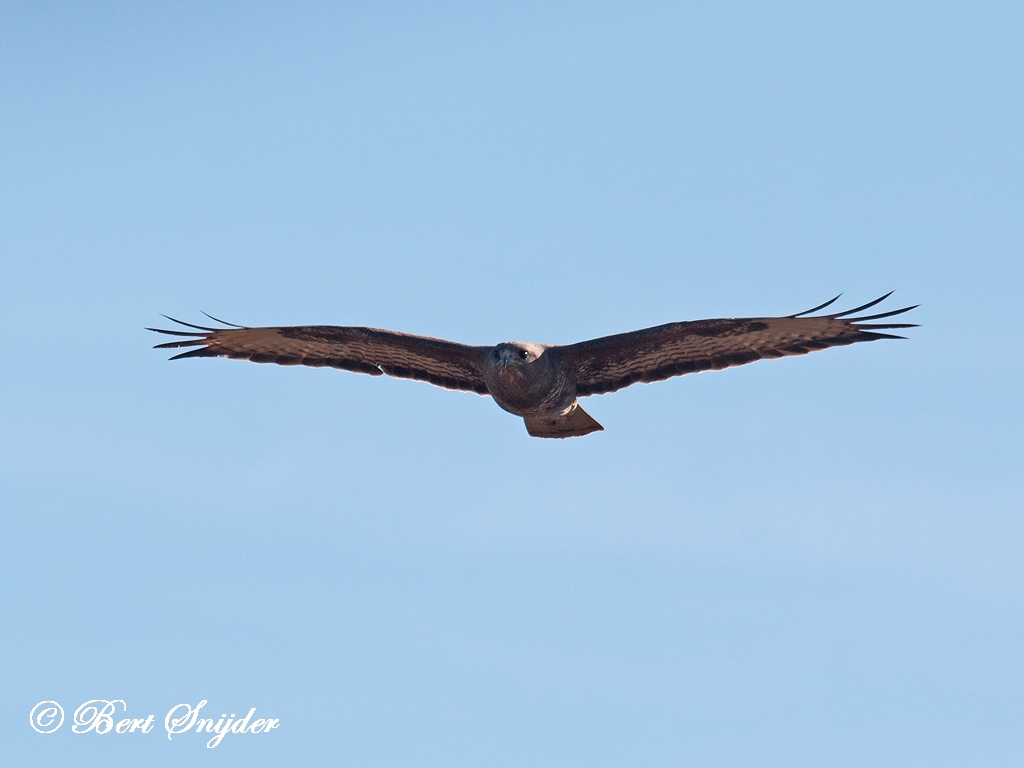Common Buzzard, Buizerd, Mäusebussard, Águia-d’asa-redonda, Ratonero común
Spotted at Monte Horizonte in the Alentejo region of Portugal. Common Buzzard sound
The Common Buzzard (Buteo buteo) is a medium to large bird of prey, whose range covers most of Europe and extends into Asia. It is usually resident all year, except in the coldest parts of its range, and in the case of one subspecies.

More photos at the bottom of this page:
The Common Buzzard measures between 40 and 58 cm (16 and 23 in) in length with a 109–136 cm (43–54 in) wingspan and a body mass of 427–1,364 g (0.94–3.01 lb), making it a medium-sized raptor.
This broad-winged raptor has a wide variety of plumages, and in Europe can be confused with the similar Rough-legged Buzzard (Buteo lagopus) and the only distantly related Honey Buzzard (Pernis apivorus), which mimics the Common Buzzard’s plumage for a degree of protection from Northern Goshawks[citation needed]. The plumage can vary in Britain from almost pure white to black, but is usually shades of brown, with a pale ‘necklace’ of feathers.
The Common Buzzard breeds in woodlands, usually on the fringes, but favours hunting over open land. It eats mainly small mammals, and will come to carrion. A great opportunist, it adapts well to a varied diet of pheasant, rabbit, other small mammals to medium mammals, snakes and lizards, and can often be seen walking over recently ploughed fields looking for worms and insects. The birds have incredible strength and are therefore able to pick up food of all weights.
Buzzards do not normally form flocks, but several may be seen together on migration or in good habitat. The Victorian writer on Dartmoor, William Crossing, noted he had on occasions seen flocks of 15 or more at some places. Though a rare occurrence, as many as 20 buzzards can be spotted in one field area, approximately 30 metres apart, so cannot be classed as a flock in the general sense, consisting of birds without a mate or territory. They are fiercely territorial, and, though rare, fights do break out if one strays onto another pair’s territory, but dominant displays of aggression will normally see off the interloper. Pairs mate for life. To attract a mate (or impress his existing mate) the male performs a ritual aerial display before the beginning of spring. This spectacular display is known as ‘the roller coaster’. He will rise high up in the sky, to turn and plummet downward, in a spiral, twisting and turning as he comes down. He then rises immediately upward to repeat the exercise.
The call is a plaintive peea-ay, similar to a cat’s meow.





Other synonyms:
Afrikaans: Bruinjakkalsvoel, Bruinjakkalsvoël
Asturian: Pardón, Zaperu
Azerbaijani: Adi sar
Bulgarian: obiknoven mišelov
Breton: Ar vaou boutin, baou, Zapelatz arrunt
Catalan: aligot, Aligot comú
Catalan (Balears): Aligot
Valencian: Aligot comú
Welsh: Bod teircail, Boda, Boda llwyd, Boncath, bwncath
Danish: Musvåge
German: Bussard, Maeusebussard, Mäusebussard, Mäusebussard-buto
Emiliano-romagnolo: Puiàn
English: Buzzard, Common buzzard, Eurasian buzzard, European Common Buzzard, Steppe Buzzard
Esperanto: buteo
Spanish: Aguila ratonera, buharro, Busardo Común, Busardo Ratonero, Ratonero común
Estonian: hiireviu
Basque: Aligot comú, zapelatz, Zapelatz arrunt, Zapelatz arrunta
Finnish: Hiirihaukka
Faroese: músvákur
French: buse, Buse des steppes, Buse variable, Épervier d’Europe
Friulian: cagne, poiane
Frisian: Mûzebiter, mûzefalk
Irish: bexato, clamhán, miñato
Gaelic: Clamhan
Galician: Aligot comú, Bexato, Miñato, Miñato común
Manx: shirragh
Croatian: mišar, Škanjac, Škanjac mišar
Hungarian: Egerészölyv, ölyv
Indonesian: Elang Buteo
Icelandic: Músvákur
Italian: Matàs, Poiana, Poiana comune, Poiana delle steppe, Poiana eurasiatica
Brescian: Matàs, Poiana
Japanese: Kuso-tobi, nosuri
Karelian: Hiirihaukku
Cornish: bargos
Kwangali: Siimbi
Latin: Buteo buteo, Buteo buteo buteo, Buteo vulpinus
Ladino: gabinel
Ladin: Gabinel
Lithuanian: Klykuolis, Paprastasis suopis, Piepis, suopis, Vakarinis suopis
Malay: Helang Gempal
Dutch: buizerd
Norwegian: musvåk, Ormhauk, Skjorvengje, Vasspip
Occitan: tartana
Polish: myszolów
Portuguese: águia de asa redonda, Águia-d’asa-redonda, Águia-de-asa-redonda, Bútio-comum, milhafre
Romansh: girun da mieurs
Romanian: sorecar
Romany: Worla, Worolo, worolo worla
Russian: kanjuk
Sardinian: Apayoni, atturistu, istore pudarzu, lepperadore, Pigana, pilloni farrancau, Spraperi, stori furapuddas, sutzulia, tappàiu, Tappayu, tzampaghe, tzueddia, tzurrulliu, tzurulia, Zueddìa
Scots: àrmhaigh, Clamhan
Northern Sami: sáhpánboaimmáš, sáhpánfálli
Slovak: Myšiak hôrny, myšiak lesný, myšiak lesný (myšiak hôrny)
Slovenian: kanja, navadna kanja
Albanian: huta
Serbian: Jastreb mišar
Sotho, Southern: Khajoane
Swedish: Ormvråk
Swahili: Shakivale-nyika
Tswana: Phakwê
Venetian: Poia
Sorbian, Lower: pašturlica
Sorbian, Upper: paskulica, pašturlica
Birdwatching in the Alentejo for birders, birds in Portugal. Guided Birdwatching Tours & Trips